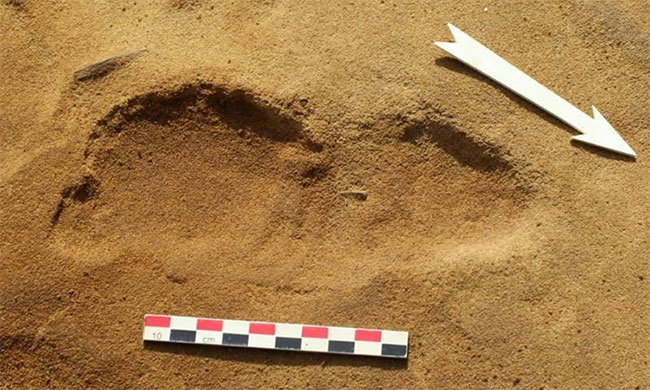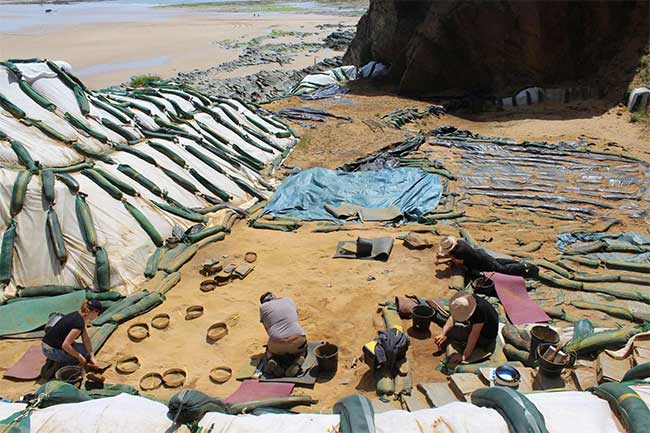Discovered human footprints buried in the sand 80,000 years
Hundreds of children's footprints near the Normandy coastline help to reveal a bit about the height and life of the ancients.
The team analyzed 257 Neanderthal footprints in Le Rozel, near the coast of Normandy, northern France. They belong to a group of 10-14 people, most of them children, including a 2-year-old baby, The Telegraph reported on 10/9.

Neanderthal footprints under thick sand near the French coast.(Photo: Telegraph).
The size of the feet of a few adults shows that they are very tall, about 190cm. According to the scientists, these footprints were imprinted on the mud, then the wind blew the sand, buried and preserved them for tens of thousands of years.
Amateur archaeologist Yves Roupin found the site in the 1960s. However, it was not until 2012 that excavation was conducted before concerns about wind and tidal erosion. Experts use machines to dig up dozens of meters of sand, reaching the sand layer to store footprints.
They found 257 footprints from 2012-2017, then hundreds more. Each footprint was photographed and modeled in 3D, some of which were molded. In 2017, thanks to new chemical techniques, the team removed hundreds of footprints from Le Rozel for storage elsewhere.
In addition, experts also discovered many stone tools at Le Rozel. They existed before modern humans (Homo sapiens) lived in western Europe.

Scientists conducted excavations of hundreds of footprints at Le Rozel.(Photo: Telegraph).
Neanderthals are close relatives of modern humans in evolutionary history. Before excavating Le Rozel, archaeologists had only discovered nine Neanderthal footprints in Greece, Romania, Gibraltar and France."The keeping of the footprint is very magical and needs a lot of luck. The footprints help reveal a bit about the life of the ancients in a short period of time," said Jeremy Duveau, an expert at the Museum of History. French National Nature, co-author of the study, said.
However, Duveau did not know if the lack of adult figures in Le Rozel was because they died young, were elsewhere or not out at the time. Maybe Neanderthals also want to play on the beach like they do today.
- The footprints of the prehistoric man 3.6 million years reveal many secrets
- Discovered fossil giant footprints in western China
- Found 400 human footprints intact 19,000 years ago
- Human footprints date back to 25,000 years in Mexico
- Found footprints of people who lived 800,000 years ago
- Footprints of 5.7 million years in Greece challenge evolution theory
- Australia discovered human footprints in the ice age
- The 15,600-year-old footprint confirms human history in the Americas
- Discovering extremely rare footprints of ancient people 14,000 years ago
- Where does sand in the sea come from?
- Discovered ancient elephant footprints
- Discovering footprints from the Stone Age 5000 years ago
- Again the traces of 'legendary footprints' appeared?
- Discovered rare dinosaur footprints 170 million years ago
 Discovered an ancient centipede fossil 99 million years old
Discovered an ancient centipede fossil 99 million years old Discovered bat-like dinosaurs in China
Discovered bat-like dinosaurs in China Discovered a 200-year-old bronze cannon of the coast
Discovered a 200-year-old bronze cannon of the coast Discover 305 million-year-old spider fossils
Discover 305 million-year-old spider fossils Discovery of fossilized dinosaur footprints dating back about 120 million years
Discovery of fossilized dinosaur footprints dating back about 120 million years  Discovering a 9,000-year-old work of art next to dinosaur footprints
Discovering a 9,000-year-old work of art next to dinosaur footprints  New species discovered 3.7 million years old: The bearer of 'bear steps'
New species discovered 3.7 million years old: The bearer of 'bear steps'  Jurassic dinosaur vestige found in southwestern China
Jurassic dinosaur vestige found in southwestern China  Discover a prehistoric crocodile 3m long walk on two feet
Discover a prehistoric crocodile 3m long walk on two feet  Africa's largest fossil footprints reveal how the ancients sought food
Africa's largest fossil footprints reveal how the ancients sought food 